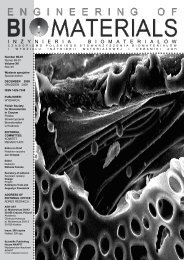69-72 - Polskie Stowarzyszenie BiomateriaÅów
69-72 - Polskie Stowarzyszenie BiomateriaÅów
69-72 - Polskie Stowarzyszenie BiomateriaÅów
You also want an ePaper? Increase the reach of your titles
YUMPU automatically turns print PDFs into web optimized ePapers that Google loves.
Streszczenie<br />
W pracy przedstawiono ocenę działania hemolitycznego<br />
i hemostatycznego matryc żelatynowo-alginianowych<br />
oraz matryc sieciowanych mleczanem<br />
wapnia po czasowym kontakcie z krwią w badaniach<br />
in vitro. Na podstawie uzyskanych wyników badań<br />
stwierdzono, że matryce nie wywołują istotnych zmian<br />
w wartościach odsetka hemolizy i stężenie hemoglobiny<br />
osoczowej. Powodują aktywację układu krzepnięcia,<br />
skrócenie czasu rekalcynacji krwi i wydłużenie<br />
APTT. Wartości pomiarowe mieszczą się w zakresie<br />
wartości referencyjnych oznaczonych parametrów.<br />
Słowa kluczowe: matryce żelatynowo-alginianowe,<br />
działanie hemolityczne, aktywacja układu<br />
krzepnięcia<br />
[Inżynieria Biomateriałów, <strong>69</strong>-<strong>72</strong>, (2007), 76-81]<br />
Wprowadzenie<br />
Materiały polimerowe są stosowane w medycynie jako<br />
opatrunki oraz materiały hemostatyczne [1,2]. Zastosowanie<br />
polimerowych nośników leków w postaci implantów pozwala<br />
na uzyskanie przedłużonego w czasie uwalniania substancji<br />
leczniczej w ściśle określonym miejscu. Natomiast<br />
użycie do ich otrzymania polimerów biodegradowalnych<br />
oraz resorbowalnych umożliwia uzyskanie postaci leku<br />
nie wymagającej ponownej interwencji chirurgicznej. Od<br />
dawna są znane zalety miejscowego podawania substancji<br />
leczniczej w opatrunkach z polimerów bioresorbowalnych,<br />
takich jak żelatyna i alginiany. Stwierdzono, że żelatyna<br />
w preparatach do podania parenteralnego powodowała<br />
spowolnienie uwalniania leku [3]. Na bazie wyżej opisanych<br />
polimerów opracowano technologię wytwarzania porowatej<br />
matrycy żelatynowo-alginianowej, jako nośnika dla substancji<br />
leczniczej, która tak jak zastosowane polimery powinna<br />
odznaczać się biologiczną obojętnością [4-7]. Badania<br />
w kontakcie z krwią matryc żelatynowo-alginianowych pozwolą<br />
na określeniu wzajemnych oddziaływań pomiędzy<br />
matrycą, a elementami morfotycznymi i białkami krwi.<br />
Celem pracy była ocena wpływu matryc żelatynowoalginianowych<br />
na elementy morfotyczne i białka krwi<br />
w warunkach in vitro w układzie statycznym.<br />
Materiał<br />
Do badań użyto dwóch rodzajów matryc żelatynowo–alginianowych<br />
o strukturze gąbki przygotowanych w Katedrze<br />
Technologii Leku AM we Wrocławiu. Gąbki uzyskano poprzez<br />
spienienie mieszaniny jałowych roztworów żelatyny<br />
(20%), alginianu sodu (4%) w stosunku 8:2 i glicerolu<br />
w ilości 3% masy żelatyny. Dodatkowo jedną z serii poddano<br />
sieciowaniu za pomocą 4% roztworu mleczanu wapnia.<br />
Uzyskane spienione mieszaniny liofilizowano przez 24 h.<br />
Otrzymano suche jałowe matryce w postaci gąbek w kształcie<br />
walca o średnicy około 8,5mm i wysokości około 3cm<br />
o masie około 0,0250±0,006g.<br />
Metody<br />
Badania cech farmaceutycznych<br />
Dla wytworzonych, gąbek wykonano badania cech farmaceutycznych:<br />
oznaczenie średniej gęstości teoretycznej<br />
zdolności sorpcyjnych [4-7].<br />
Abstract<br />
The paper presents an evaluation of hemolytic<br />
and hemostatic activity of gelatin-alginate matrixes<br />
and cross-linking of the matrix with calcium ions after<br />
contact with human blood in vitro studies. In view of<br />
the results in has been reported that a matrix does not<br />
cause important quantitative changes in the percentage<br />
of hemolysis and free hemoglobin concentration.<br />
In the plasma coagulation system evaluation blood<br />
recalcyfication time was shortened and activated<br />
partial thromboplastin time (APTT) was prolonged.<br />
That suggested that coagulation processes were<br />
activated.<br />
Keywords: gelatin-alginate matrixes, hemolytic<br />
action, coagulation system activation<br />
[Engineering of Biomaterials, <strong>69</strong>-<strong>72</strong>, (2007), 76-81]<br />
Introduction<br />
Polymeric materials are used in medicine as dressings<br />
and hemostatic materials [1,2]. Use of polymeric carriers of<br />
drugs in the form of implants will allow to obtain release of<br />
therapeutic substance in precisely defined place prolonged<br />
in time. On the other hand the achievement of the form of<br />
drug not requiring a new surgical intervention is enabled<br />
by their use to obtain biodegradable polymers. The values<br />
of local application of therapeutic substance in dressings<br />
from bioresorbable polymers such as gelatin, alginates have<br />
been known for a long time. It was observed that gelatin in<br />
preparations for parenteral application caused slowness<br />
of drug release [3]. On the basis of the above described<br />
polymers the technology of production of porous gelatinalginate<br />
matrix as a carrier for therapeutic substance was<br />
worked out which should show, similarly as the used polymers,<br />
biological neutrality [4-7]. Studies of gelatin-alginate<br />
matrixes in contact with blood will allow to determine mutual<br />
reactions between the matrix and the morphotic elements<br />
and blood proteins.<br />
The purpose of the work was evaluation of the influence<br />
of gelatin-alginate matrixes on the morphotic elements and<br />
blood proteins in conditions in vitro in the static system.<br />
Material<br />
Two kinds of gelatin-alginate matrixes with the sponge<br />
structure prepared in Department of Drug Form Technology<br />
in Wroclaw Medical University were used. Sponges were<br />
obtained through foaming of a mixture of sterile solutions<br />
of gelatin (20%), sodium alginate (4%) in relation 8:2 and<br />
glycerol in quantity of 3% gelatin mass. Additionally, one of<br />
the series was cross-linked with the help of 4% solution of<br />
calcium lactate. The obtained mixtures were lyophilized over<br />
24 hours. Dry sterile matrixes in the form of sponges, shape<br />
of a cylinder, with diameter about 8.5mm and height about<br />
3cm, with mass about 0.0250± 0.006g were obtained.<br />
Methods<br />
Pharmaceutic features studies<br />
Determination of mean theoretical density [4-7] and sorption<br />
ability were performed for the obtained sponges.<br />
77













